
The traditional clothing and accessories worn in Khyber Pakhtunkhwa varies according to the area of the region. The following outfits are generally worn in the area, starting to north to south:
Chitral: Shushut, Chehare , beaded necklaces worn by Kalasha women
khoi caps worn by Kho women and Chitrali Pakol worn by kho men
kohistan: Kohistani dresses called Jumlos and Ghokhru bangles worn by women as well as Kohistani hats worn by children
Hazara: Makhmal Shalwar Kameez, Makhmal belt and Makhmal necklace worn by Hazarewal Hindko speaking women
Waziristan: Waziristan Pakol worn by Pashtun men and Ganr Khat dress worn by Pashtun women in southern Waziristan
Khat partug
The traditional clothing for the lower region is the khat partug which is a shalwar kameez combination and is worn by men and women. The khat (also called khattaki or in Marwat Pashtu, kamis)[1] is the shirt which fits closely to the body to the waist and then flares out, either to the knees, or in the case of women, to the ankles. The khat worn by women can be elaborately embroidered at the neck with needle work.
The partug (also called pardig) is a loose shalwar which has many folds and is loosely brought together at the ankles. Men also wear a turban and a scarf (called patkai),[1] while women wear a head scarf.
 Traditional Khet partug. (Traditional loose shalwar worn in Khyber Pakhtunkhwa) (1842)
Traditional Khet partug. (Traditional loose shalwar worn in Khyber Pakhtunkhwa) (1842)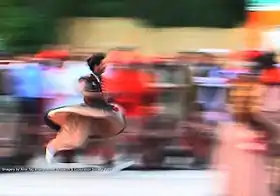 Khattak dancer wearing khat partug
Khattak dancer wearing khat partug
Firaq partug
The female khat is also known as the firaq which forms the firaq partug outfit. The female khat is of two types:[2] the jalana khat and the giradana khat. The jalana khat is worn by unmarried women which is loose and traditionally of print design. The giradana khat is worn by married women and is of dark colours, especially red. The female khat has many pleats. The styles are of the type also worn in Afghanistan.
 Afghan girls in traditional clothes
Afghan girls in traditional clothes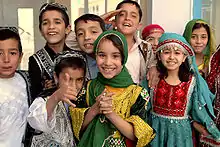 Afghan School children in Kabul
Afghan School children in Kabul 2010 Children's Day in Afghanistan
2010 Children's Day in Afghanistan Afghan kids wearing traditional clothes in Kabul
Afghan kids wearing traditional clothes in Kabul Child of Khyber Pakhtunkhwa. 1920 approx.
Child of Khyber Pakhtunkhwa. 1920 approx.
Perahan tunban/Partoog Kameez
Perahan tunban or Partoog Kameez is male dress worn in Khyber Pakhtunkhwa and eastern Afghanistan.[3] The perahan tunban/Kameez Partoog version of the shalwar kameez is made up of the perahan/Kameez (the top) which is wide and loose with the sleeves also worn loose and pendent from the arms.[4] The perahan/kameez worn in Khyber Pakhtunkhwa generally falls to the knees.[5][6][7] The traditional perahan buttons on either shoulder, is collarless[8][9] and is meant to be loose.[10] Further, the traditional perahan/kameez is wide but fits closer to the body down to the waist and then is loose and full down to the knees[11] (thereby flaring out). However, modern versions open to the front.
The tunban/partoog (lower garment) is worn loose and hanging. Some versions of the tunban/partoog have the ample folds gathered into plaits at the lower part of the legs, below the knees to the ankles and the loose part above overhangs in loops.[4] The tunban/partoog therefore uses a lot of material so that it gathers around the waist and folds around the legs. Modern versions are less voluminous.
 Clothing worn by most Pashtun males in Afghanistan and Pakistan
Clothing worn by most Pashtun males in Afghanistan and Pakistan
Sindhi cap
Although the Sindhi cap originates from Sindh, the cap is popular in Khyber Pakhtunkhwa.
 The Sindhi cap
The Sindhi cap
Peshawari kullah cap
The Peshawari cap, called kullah, is a skull cap which is quilted in cotton or silk and embroidered in local designs.[2]
Peshawar shalwar
The traditional dress of Peshawar and other parts of Khyber Pakhtunkhwa, Pakistan is the khalqa (gown) which opens at the front[12] or shirt which does not open at the front,[13] and the Peshawari shalwar which is very loose down to the ankles.[14]
Choga
The choga is an outer robe with sleeves. It is generally made of soft woollen material.[15] The choga is traditionally worn in Afghanistan and Khyber Pakhtunkhwa.[16]
The shaturi choga is made of camel's hair. The baruki choga is made with wool of rufus-woolled sheep and the kurki choga is made with highland goat's wool. Other expensive chogas are made with coarse materials.[4]
The Kabuli pashum is the choga made with the fleece of dumba, fat-tailed sheep of Peshawar and Kabul. The fleece produces fine quality material.[17]
 Pashtun dress 1851
Pashtun dress 1851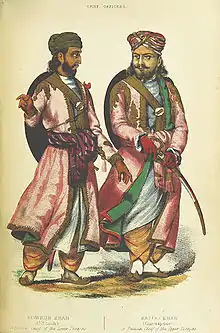 Derajat Pashtuns 1851
Derajat Pashtuns 1851
Sharai
The sharai is a woollen sheet which has a slit in it for the head. The sheet is long and is tied around the waist with a belt.[2] The sharai can also be short and worn with a kammarband (waist band) made of coarse material or leather.
Turban
The turban is known as the dastar[2] which can be voluminous and long.
Upper regions/Kalash
The dress in Kalash, Chitral District is the long robe. The robe can either be of wool or cotton,[18] and is referred to as the chugha or shoqa. This type of robe is also traditionally worn in the neighbouring Hunza Valley of Gilgit-Baltistan where the garment is referred to as the choga.[19]
In Chitral, the men traditionally wear mid-calf-length straight-legged loose woollen trousers which are supplemented by woollen leggings in winter. This links the region to the Nuristani region in adjoining Afghanistan to its west where men traditionally wore white woollen trousers reaching to just below the knees, supplemented by black tight leggings, covered by a long tunic tied at the waist.[20] Men of Chitral also wear loose shirts and woollen waistcoats or coats and the Chitrali cap with a sprig of juniper tucked into its brim.[21][22]
The women wear very loose shalwars. Women's dresses are made with eight to ten yards of black cotton cloth, which is heavily embroidered around the neck, sleeves and bottom with skeins of yarn. A thick woollen or yarn belt is tied three or four times around the waist. Women wear beads around the neck. The headdress consists of two parts, the smaller susutr (woven woollen circle) which rest at the back of the head and has a long run down the back. The larger item is the kapas which rests above the susutr. Where the susutr is worn at all times, the kapas, which is highly decorated is worn on special occasions, or when visiting other valleys.[23]
 Kalash women traditional clothing
Kalash women traditional clothing Kalash girl
Kalash girl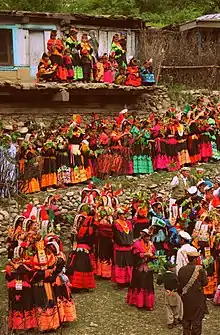 Celebrating Joshi, Kalash women and men dance and sing their way from the dancing ground to the village arena, the Charso, for the end of the day's festivities.
Celebrating Joshi, Kalash women and men dance and sing their way from the dancing ground to the village arena, the Charso, for the end of the day's festivities.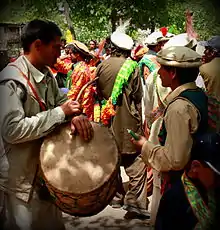 A drummer during the Joshi festival in Bumberet, Pakistan. Drumming is a male occupation among the Kalash people.
A drummer during the Joshi festival in Bumberet, Pakistan. Drumming is a male occupation among the Kalash people.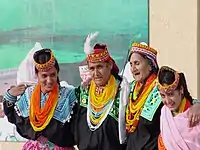 Kalasha women
Kalasha women Drummer boy Chitral
Drummer boy Chitral Rumbur Valley, Chitral, NWFP, Pakistan Kalash girl in Rumbur. The girl is dressed in a dark gown and carries jewellery: a ring, a necklace and a headdress (kupa) covered with shells (kauri or cowri). On top of the headdress there is a tassle (probably red) and a second one, smaller, is visible above her forehead. Her shoes are also clearly visible. 1929 approx.
Rumbur Valley, Chitral, NWFP, Pakistan Kalash girl in Rumbur. The girl is dressed in a dark gown and carries jewellery: a ring, a necklace and a headdress (kupa) covered with shells (kauri or cowri). On top of the headdress there is a tassle (probably red) and a second one, smaller, is visible above her forehead. Her shoes are also clearly visible. 1929 approx. Urtsun (Utsun), Chitral, NWFP, Pakistan Kati boys, one dressed in a goat's skin with the typical Chitrali cap (pakol).
Urtsun (Utsun), Chitral, NWFP, Pakistan Kati boys, one dressed in a goat's skin with the typical Chitrali cap (pakol). 1929 approx. Kunisht (Rumbur Sheikhandeh), Rumbur Valley, Chitral, NWFP, Pakistan Photograph (nr. 1 of 3) reproduced from Georg Morgenstierne's unique film documentary from Chitral. Overview picture from the Kati dance. The male Kati dancers are dressed as usual for this occasion in their best clothes, silk costumes (talar) and turbans. The dance on the ground beside the dancing floor is called Zhige.
1929 approx. Kunisht (Rumbur Sheikhandeh), Rumbur Valley, Chitral, NWFP, Pakistan Photograph (nr. 1 of 3) reproduced from Georg Morgenstierne's unique film documentary from Chitral. Overview picture from the Kati dance. The male Kati dancers are dressed as usual for this occasion in their best clothes, silk costumes (talar) and turbans. The dance on the ground beside the dancing floor is called Zhige.
Chitrali cap
The Chitrali cap is made of fulled woollen cloth, and consists of a flat crown with a rolled brim. The cap is popular in Afghanistan where it forms part of Nuristani dress.[24]
 Nuristani people in Kabul, 1924
Nuristani people in Kabul, 1924 Kalash in Chitrali caps (early shapes of), 1929
Kalash in Chitrali caps (early shapes of), 1929 Tajiks of Kapisa at Bagram (Afghanistan), 2006
Tajiks of Kapisa at Bagram (Afghanistan), 2006
Suthan
In Bannu[25] and the Hazara area which includes, Mansehra, Abbottabad and Haripur District, the older traditional lower garment is the suthan as worn in the Punjab region. The suthan can either be loose to the knees and tight to the ankles, or loose to the lower legs and tight at the ankles.[26] In Bannu, the suthan is traditionally worn with a khilka, a long tunic which does not have side slits. The choga is also worn, which can be knee length or lower and is the traditional dress in Afghanistan,[4] Khyber Pakhtunkhwa and is also worn in the Punjab region.[27]
In the plains of the Hazara region, the dress is of the type worn in the Punjab region:[2] the long Punjabi kurta which has side slits is traditionally worn. The kurta is called khilka or perni.[28] However, a knee length version is also worn in the lower area. The khilka/perni is worn with a loose Punjabi suthan which is tight at the ankles.
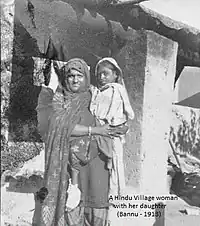 Bannu Woman and daughter 1913
Bannu Woman and daughter 1913 1907 Bannu
1907 Bannu Mazeri-madi 1913
Mazeri-madi 1913 Mal Mandi Bannu -1914
Mal Mandi Bannu -1914
See also
References
- 1 2 NWFProvince. Gazetteer of Bannu District Part A 1907
- 1 2 3 4 5 Baden-Powell, Baden. Henry (1872) Hand-book of the Manufactures and Arts of the Punjab
- ↑ Charpentier, Carl-Johan (1972) Bazaar-e Tashqurghan--ethnographical studies in an Afghan traditional bazaar
- 1 2 3 4 Bellew, Henry Walter (1862) Journal of a political mission to Afghanistan, in 1857
- ↑ Elphinstone, Mountstuart (1815) An Account of the Kingdom of Caubul, and Its Dependencies in Persia, Tartary, and India: Comprising a View of the Afghaun Nation, and a History of the Dooraunee Monarchy
- ↑ "The Culture of Afghanistan". HilalPlaza.com.
- ↑ Willem V Ogelsang (2007-2009) What Afghan Men Used to Wear in the Early Nineteenth Century
- ↑ Foundation, Encyclopaedia Iranica. "Welcome to Encyclopaedia Iranica". iranicaonline.org.
- ↑ Yar-Shater, Ehsan (September 28, 1982). Encyclopaedia Iranica. Routledge & Kegan Paul. ISBN 9780710090904 – via Google Books.
- ↑ Charpentier, Carl-Johan (1972) Bazaar-e Tashqurghan--ethnographical studies in an Afghan traditional bazaar
- ↑ Elphinstone, Mountstuart (1842) An account of the kingdom of Caubul, and its dependencies, in Persia, Tartary, and India (1842)
- ↑ North-West Frontier Province (Pakistan). Information Dept Yearbook(1955)
- ↑ Peshawar, University of (September 28, 1952). "Journal of the University of Peshawar" – via Google Books.
- ↑ Captain Hastings, E. G. G. (1878) Report of the regular settlement of the peshawar district of the punjab
- ↑ Sir Henry Yule, Arthur Coke Burnell (1903) Hobson-Jobson: A Glossary of Colloquial Anglo-Indian Words and Phrases, and of Kindred Terms, Etymological, Historical, Geographical and Discursive
- ↑ Balfour, Edward (1873) Cyclopædia of India and of Eastern and Southern Asia, Commercial, Industrial and Scientific: Products of the Mineral, Vegetable and Animal Kingdoms, Useful Arts and Manufactures, Volume 5
- ↑ Hogg, James. Marrya, Florence .(1870) London Society, Volume 15; Volume 17
- ↑ Horace Arthur Rose, IBBETSON, Maclagan (1996) A Glossary of the Tribes and Castes of the Punjab and North-West Frontier Province: Vol. 1
- ↑ "Social Science Abstracts". Published under the auspices of the Social Science Research Council, by Social Science Abstracts, Incorporated. September 28, 1930 – via Google Books.
- ↑ Condrad, Jill (2013) Encyclopedia of National Dress: Traditional Clothing Around the World
- ↑ Claus, Peter J. Diamond, Sarah. Mills, Margaret Ann (2003)South Asian Folklore: An Encyclopedia : Afghanistan, Bangladesh, India, Nepal, Pakistan, Sri Lanka
- ↑ 1998 District Census Report of [name of District].: Chitral
- ↑ Maggi, Wynne (2001) Our Women are Free: Gender and Ethnicity in the Hindukus
- ↑ Condra, Jill (2013) Encyclopedia of National Dress: Traditional Clothing Around the World
- ↑ Gazetteer of the Bannu District:1883 .
- ↑ "Punjab District and State Gazetteers: Part A]". Compiled and published under the authority of the Punjab government. September 28, 1932 – via Google Books.
- ↑ Punjab District Gazetteers: Phulkian states. Patiala Jind and Nabha, 1909
- ↑ Watson, Hubert Digby (September 28, 1992). "Gazetteer of the Hazara District, 1907". Sarhad Urdu Academy – via Google Books.